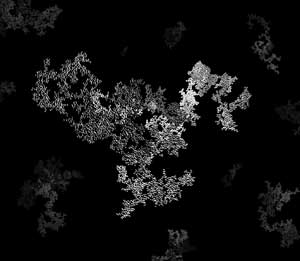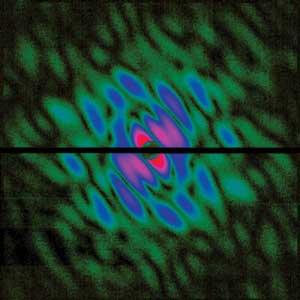
Laser probes pollution particles
X-rays from the Linac Coherent Light Source (LCLS) are providing the most detailed images to date of airborne soot particles, an investigation that will have important implications for climate modeling and human health.
Aerosol particles such as soot are significant in fields ranging from toxicology to climate science, but their properties are difficult to measure: Visible light does not provide adequate resolution, x-ray sources are typically not bright enough to image single particles, and, for electron microscopy, particles must be collected onto a substrate, a move that could alter their structure and encourage agglomeration.

An investigation using x-rays from the Linac Coherent Light Source has helped researchers better understand the structure of airborne soot particles. These simulated particles, based on previous research models, illustrate the expected fractal structure of soot particles in the air. The latest research shows that soot particles produced as aerosols can be noticeably denser than the ones shown here. Courtesy of Duane Loh and Andy Freeberg, SLAC National Accelerator Laboratory.
Now, scientists from the Center for Free-Electron Laser Science – a joint venture of Deutsches Elektronen-Synchrotron DESY, the German Max Planck Society and the University of Hamburg – have used the world’s most powerful x-ray laser, the LCLS, at the US Department of Energy’s SLAC National Accelerator Laboratory in Stanford, Calif., to image a single soot particle floating through a laser beam.
“We now have a richer imaging tool to explore the connections between their toxicity and internal structure,” said Duane Loh of SLAC, lead author of the study.
In the experiment, the team wafted individual soot particles up to 3.25 µm in diameter into the path of the laser beam. The laser pulses were so brief that they captured information about the particles, only millionths of a meter across, in the quadrillionths of a second before they blew apart. The information produced a characteristic diffraction pattern that was recorded by a detector. From this pattern, the scientists reconstructed the structure of the soot particle.
“The structure of soot determines how it scatters light, which is an important part of understanding how the energy of the sun is absorbed by the Earth’s atmosphere,” said Andrew Martin of DESY. “This is a key factor in models of the Earth’s climate.”
The study focused on particles less than 2.5 µm in diameter, the size range that efficiently transports into the human lungs and that constitutes the second most important contribution to global warming.

The diffraction pattern of a single soot particle. Results from studies of soot particles are expected to affect climate modeling and human health. Courtesy of Duane Loh et al.
“There also are many links between airborne particles around 2 µm in size and adverse health effects,” Martin said. “Using the free-electron laser, we are now able to measure the shape and composition of individual airborne particles. This may lead to a better understanding of how these particles interfere with the function of cells in the lungs.”
The team recorded patterns from 174 soot particles and measured their compactness using fractal dimension. They discovered that no two are alike. Soot particles exhibit similar patterns of complexity at different scales, which is characteristic of fractals.
“There is quite some variation in the fractal dimension, which implies that a lot of rearrangement is going on in the air,” said DESY scientist Henry Chapman.
The results have made scientists wonder what diversity of forms will be discovered if particles produced in real-world “messy” environments, such as a car’s combustion engine or a candle flame, are imaged one at a time. The team is analyzing data from experiments at the LCLS that examined soot from diesel emissions as well as other types of airborne particles.
The primary long-term goal of the research is to take snapshots of airborne particles as they change in size, shape and chemical makeup in response to their environment, said Michael Bogan of SLAC.
“Scientists can now imagine being able to watch the evolution of soot formation in combustion engines from their molecular building blocks, or maybe even view the first steps of ice crystal formation in clouds,” Bogan said.
“Biological samples, like cells and large proteins, have a similar size to the soot particles we studied and also lack fixed reproducible structure,” Martin said. “In the future, it may be possible to extend these techniques beyond aerosols, to study the structural variations in biological systems.”
The research was published in Nature (doi: 10.1038/nature11222).
Published: September 2012